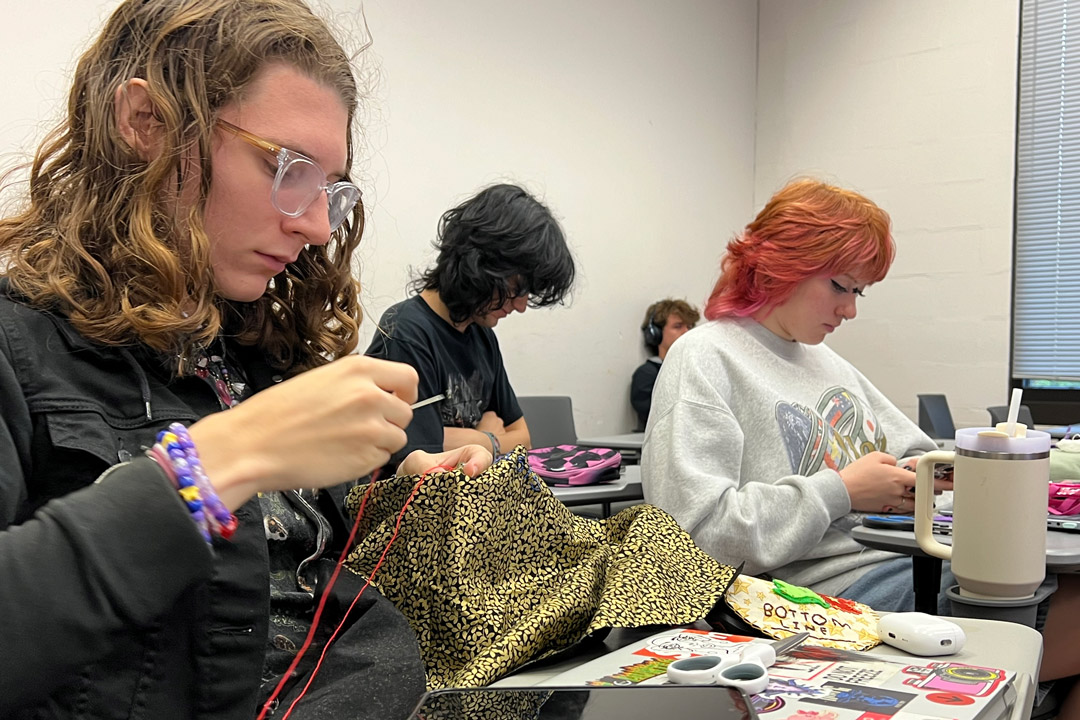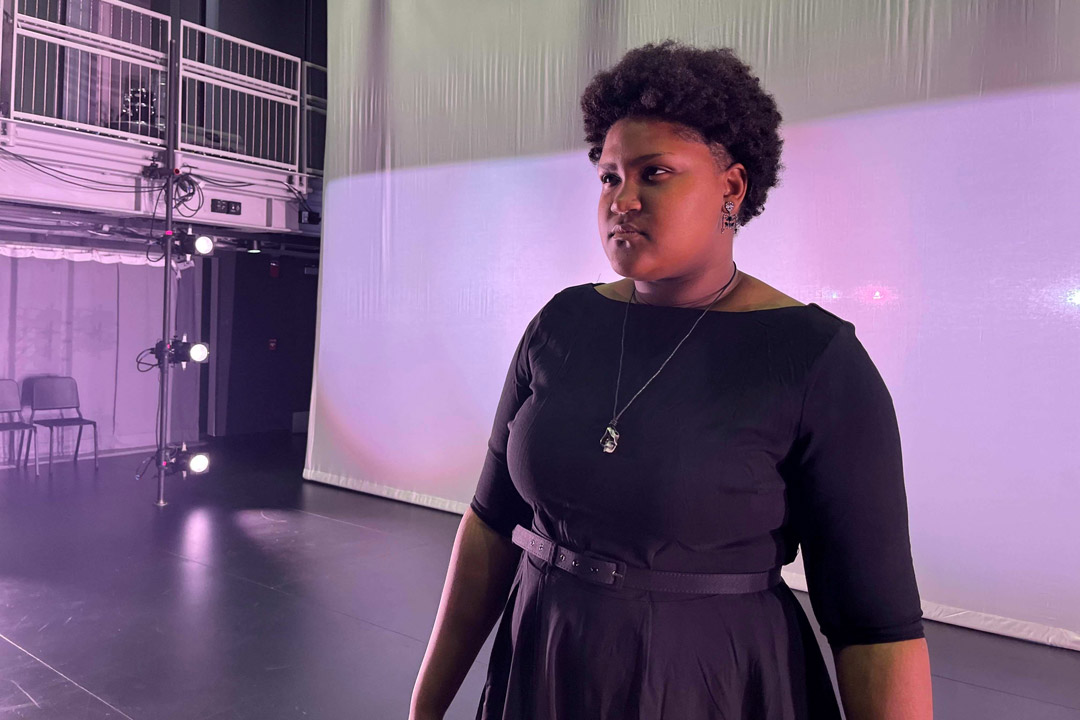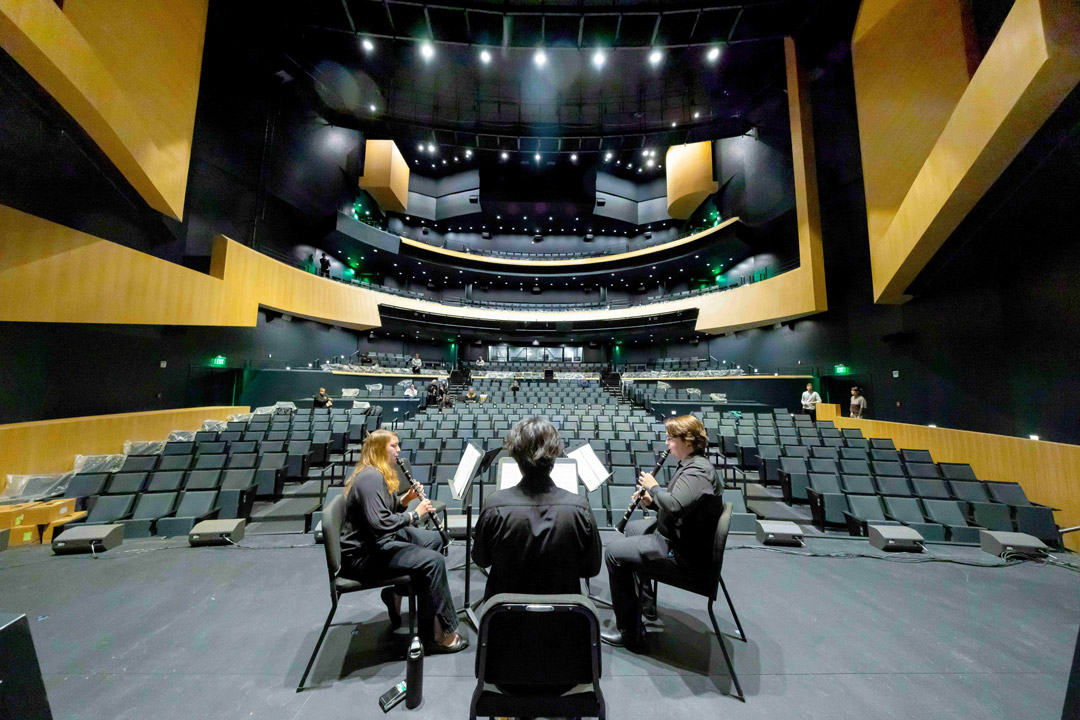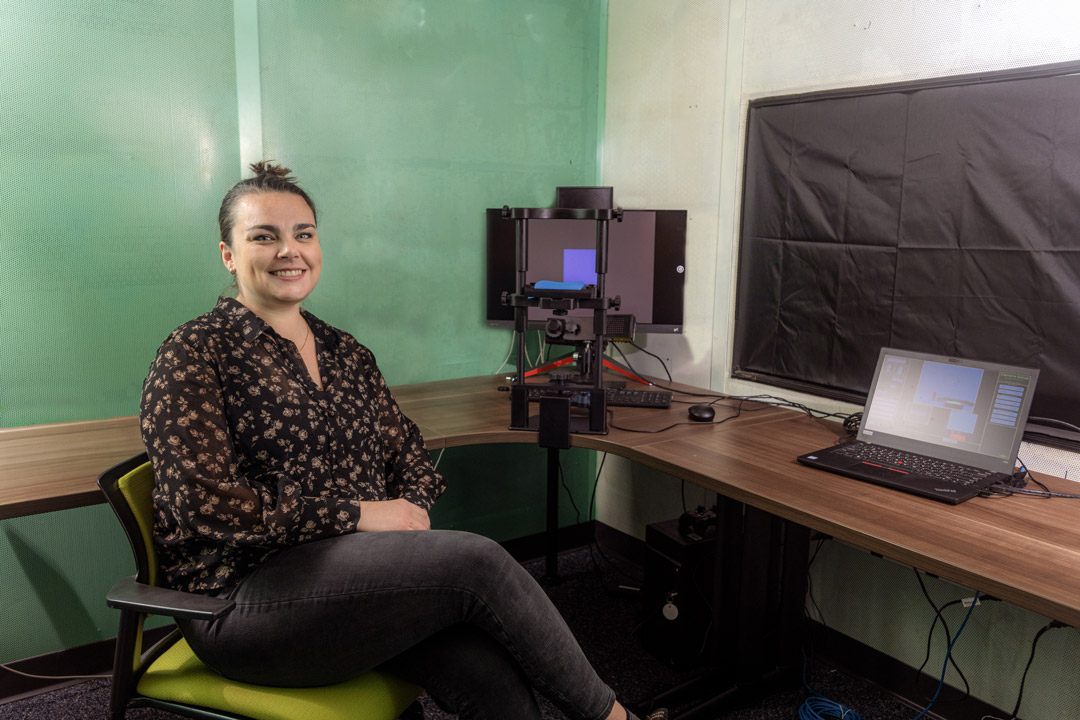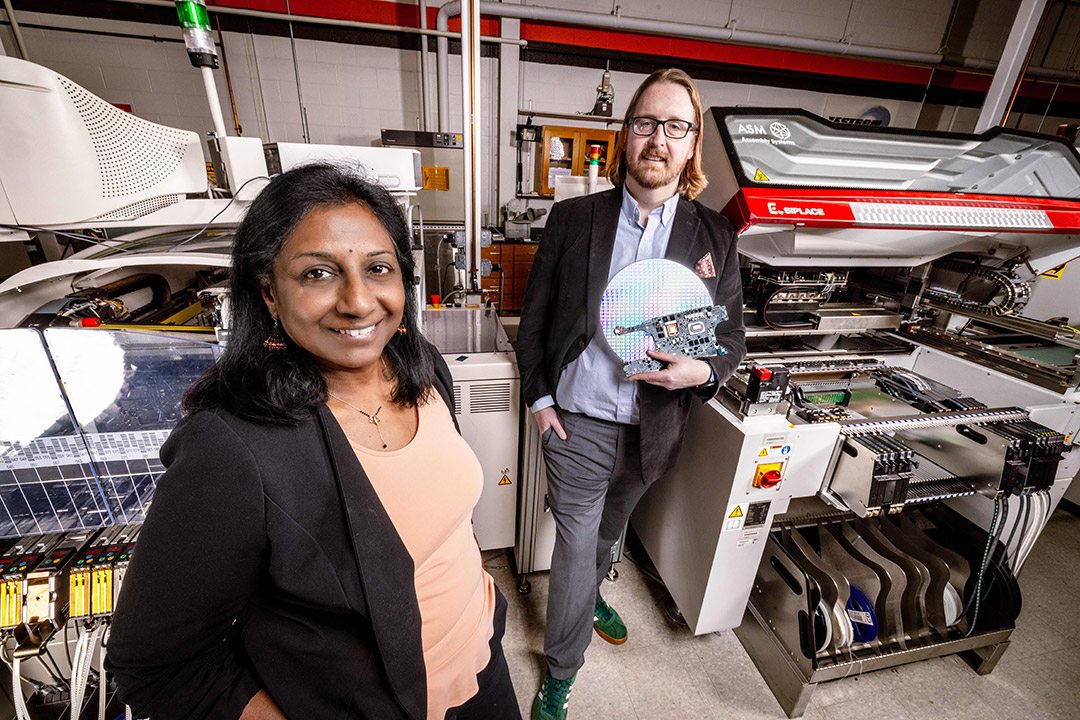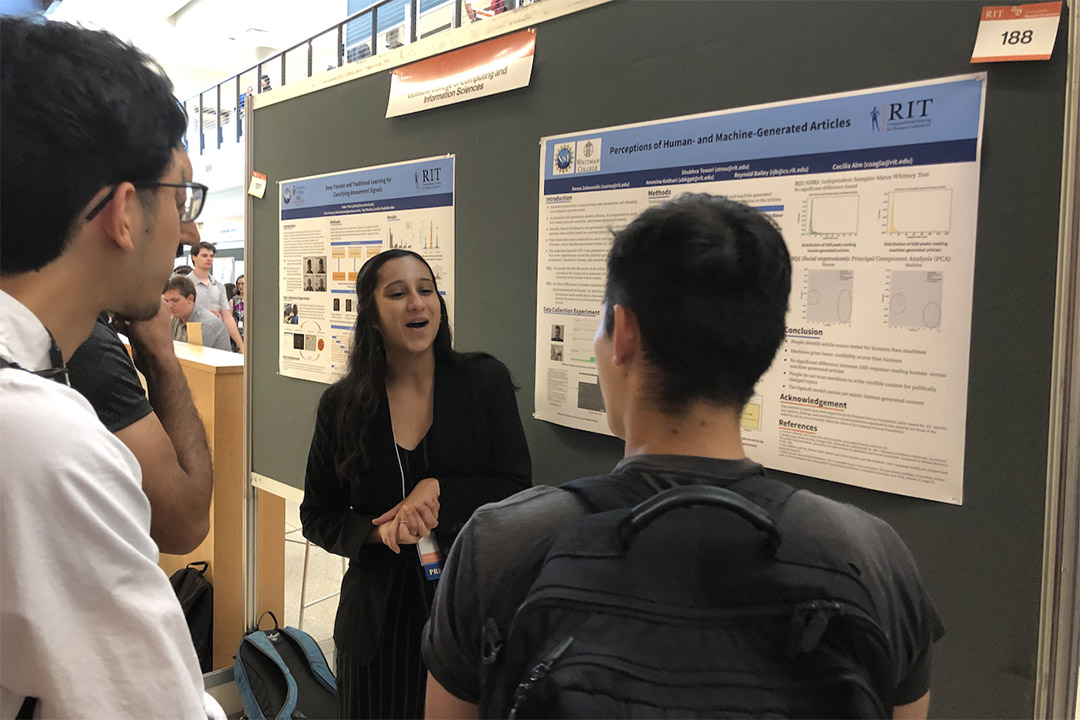Students ditch doomscrolling for hand-stitched expression
Casting aside the daily doomscroll and picking up a slow hobby like hand-stitched embroidery can provide a much-needed brain break for students. It can also open the door for them to give back to the community while expressing themselves.
Get your own patch
The Visual Activism class’s patch sale will begin on Friday, Nov. 7, from 5 to 8 p.m. at The Op Shop. Remaining patches will be on sale at the shop through Jan. 1, 2026.
Professor Hinda Mandell introduced students to this rejuvenating, slow hobby through a new Visual Activism course. The students’ efforts to create and sell hand-stitched patches and buttons will directly benefit Foodlink, a Rochester-based nonprofit dedicated to ending hunger and building healthier communities by addressing the symptoms and root causes of food insecurity.
Each student in the Visual Activism class created three patches or buttons—hand-stitched with their own personal messages—to be sold at The Op Shop during the Nov. 7 First Friday Rochester citywide event. The bulk of the sales will be donated to Foodlink, and a portion of the proceeds will go to The Op Shop, a local vintage store owned by Joanna (Jo) Carroll. The students submitted pitch papers and voted as a class to select a local charity to support.
Eva Witten, a second-year cybersecurity major from Hartford, Conn., said giving back to the local community through her handmade work was a meaningful opportunity.
“It feels like I’m contributing to something that matters. It’s an act that makes a direct, measurable impact, while also being something that I enjoy working on,” she said.
From hand-stitched patches and ribbons, to hand-sewn shirts, to zines expressing their own personal activist manifestos, Mandell said her goal when crafting assignments for the course was exposing students to the variety of ways they can express their beliefs beyond spoken or written words.
“So much activism today, especially for university students, seems to unfold in online spaces,” said Mandell. “I believe in the benefits of hand stitching and engaging with an act that is slow and methodical. I wanted students to have a tactile experience that really connects their own beliefs and opinions to something that they can hold.”
This is the first semester Mandell has offered Visual Activism. When she asked The Op Shop to collaborate, Carroll thought that the coursework was a perfect fit for a First Friday event at the shop.
Carroll curates monthly exhibitions at the shop in collaboration with First Friday to highlight local artists. This month, the spotlight will be on the Visual Activism students’ work.

Jennelle Hart/RIT
Professor Hinda Mandell said the patch and button project’s open-ended nature allowed her students to pursue topics that “expressed a piece of their heart,” and that the students were “truly delighted” by the work of their classmates.
“November holds a collective pulse: a time when voices rise to be heard, when we exercise our rights through voting, and when nature itself reminds us of cyclical change,” said Carroll. “Through weaving, stitching, and felting, the students channel the physical and political forces that shape our world. Each piece reflects the belief that creation itself is a form of protest.”
Witten said she carries her skills and knowledge of hand stitching outside of the classroom. From helping other students in her dorm mend their clothing, to forming friendships through conversations sparked by her expressive patches, Witten found that the hobby has opened doors to cultivating community both on campus and in her chosen field of study.
“Art is the penultimate version of self-expression. I think it has an impact on the people who see me wearing the art I’ve made,” she said. “What that impact is, is for them to decide. But I think that through influencing others with these patches, I can promote this idea of self-expression in my career field.”
Vivian Contreras, a fourth year student enrolled in the combined accelerated bachelor’s/master’s degree program, said the Visual Activism coursework connects to why she chose criminal justice as her major. Her goal after graduation is to become an immigration attorney, so her three submissions followed a theme of immigration advocacy.
“I’ve spent close to three years focusing on immigration. I felt like this assignment was an opportunity to show what matters to me and what has been on my mind. It felt like I finally had a space where I could visually show what I’ve been researching and studying for so long,” she said.
Contreras, from Mount Airy, Md., plans to incorporate a form of hand-stitching activism outreach into her master’s degree capstone project, in which she anticipates connecting with local immigrant and refugee communities.
“I think that hand stitching is a really good way to make activism tangible. I’m hoping to take what I’ve learned from this class and show it to other people so they can also speak their mind. I hope this approach to advocacy can help these communities to speak out,” she said.
Bussing is available for students interested in attending First Friday Rochester events.
For more information about the Visual Activism course and crafting activism, email Hinda Mandell at hbmgpt@rit.edu or follow her on Instagram. Go to The Op Shop’s website for more information about the shop.
Latest All News
- First-year student, Performing Arts Scholar lands major role in ‘Macbeth’As a first-year College of Liberal Arts student with a double major of humanities, computing, and design as well as sociology and anthropology, Angel Ash wasted no time trying out for a theatrical production. After arriving on campus for the first time just a few weeks before their audition, Ash landed a major role in Macbeth, with shows at 7:30 p.m. Nov. 13-16 in the SHED’s Sklarsky Glass Box Theater. You received a Performing Arts Scholarship for singing, yet you are acting in a major production in your first semester at RIT. How’d that come about? I come from a musical household; my mom worked professionally as an actress. I was in every play in middle school and a play in high school back in Princeton, N.J. So when I saw they were auditioning for Macbeth, I asked myself, “Why not apply for it?” I love Shakespeare. I’ve read Shakespeare for English class, but also read Shakespeare for fun. I’m a big fan. How are you relating with such a malicious character? This is going to be super cool. Lady Macbeth is ruthless. I can relate a lot to her character. I consider myself an extrovert, but I’ve played a villain before. She’s such a complex character. I get to really bring out my dark side and tell a story that’s really important about wanting more for yourself. She went through a lot of pressure. I’m just really loving it. Lady Macbeth is the best thing that has happened to me. It’s such an honor to portray her. The play’s director, Ryan Underbakke, says Macbeth speaks to the turbulence of our time and reminds us how easily power can corrupt, how fragile our sense of order can be, and how the choices we make ripple far past the present. Do you think this play, relates to our world today? Totally. I think it’s important not to turn a blind eye on current events in society. People are feeling so isolated, and a lot of people don’t know themselves. With fewer and fewer places to get legitimate coverage of what’s really going on, it’s so imperative to listen to the stories that are being shared less and less as time goes on. You are pursuing a double major and a lead role in a play. Do you have time for anything else? I work as a server at Gracie’s and I’m a member of the Banned Book Club. It’s so awesome. I’m reading The Handmaid’s Tale now. I’m a big fan of reading. I’m a big fan of horror, particularly feminist horror, and I’m a cinephile. I’m also a big fan of literature and like to write poems and short stories. I’m hoping to submit mine to Signatures. And eventually I want to see more of Rochester. I hear the theater and arts community is really awesome. What motivates you? Everything I do is to help me relate to the current political situation we’re living in now. I’m doing what I can to benefit society and be the best human I could be. My mom makes me a better human. She’s my No. 1 supporter. She’s now a drama teacher at Princeton. She taught me to be true to my career. I’ve learned so much from her. What advice would you give your fellow students? They should definitely keep going to the theater. Keep looking for those shows that can introduce you to new characters and stories. Find those people you can relate to.
- Music Performance Theater passes first acoustic testFive months before the first audience is expected in RIT’s new Music Performance Theater, a string quartet from the Rochester Philharmonic Orchestra and students from the RIT Philharmonic Orchestra were the first to take the stage to help conduct acoustic testing. Ground was broken in September 2023 for the 750-seat theater. A majority of the construction is completed, and an opening night performance is scheduled for April 10, with interactive public tours during the Imagine RIT: Creativity and Innovation Festival on April 25. The first student musical theater production will be held next fall. Before he took the stage, RIT Philharmonic violinist Nathaniel Jarrett, a fourth-year computer science major and a performing arts scholar from Natick, Mass., took a seat in the center of the theater and looked around. “It’s a lot bigger than I thought,” he said. “It’s exciting to be here to be part of the acoustic testing.” The performers sat near the front of the stage, then moved to mid-stage, then to the rehearsal studio, and lastly to the orchestra pit, which is exposed when the front of the stage is lowered 10 feet. Carlos Ortiz/RIT Members of the RIT Philharmonic Orchestra, left to right, Owen Faust, Nathanial Jarrett, Lucas Kishore, and Luka Porter, perform in a rehearsal studio to test acoustics in the Music Performance Theater which will open this spring. “We’re very impressed with the way things turned out,” said Erik Bergal, one of two consultants with Nagata Acoustics, who traveled from Los Angeles to help with the testing. “We’re listening to the overall acoustical quality to make sure we get good, clear sounds and richness, and we’re obviously trying to find out if there are any issues, like echoes. We haven’t found anything that is problematic.” Bergal said it’s important that every theater patron gets a good experience with reverberant sound energy, regardless of if they are in orchestra, mezzanine, or balcony seating. He was involved in the acoustic design of the theater, working closely with renowned Los Angeles-based architect Michael Maltzan, and consulted on the interior’s shape and materials, such as the curved ceiling and textured walls. “It’s quite different than a movie theater which is designed to be an acoustically dead, neutral space with a sound engineer doing the audio work,” he said. “Here, we have to use the room itself, use the walls to keep the sound energy in the space, and get a nice distribution. What we heard today sounds great, especially the balconies sounded great.” Faculty members from RIT’s School of Performing Arts, and the school’s director, Erica Haskell, also attended. Yunn-Shan Ma, director of the RIT Philharmonic Orchestra, sat on stage with the musicians and in various seats where audience members would sit. Carlos Ortiz/RIT In the background, Elspeth Wing and Erik Bergal, acoustic consultants, listen to a string quartet from the Rochester Philharmonic play in the Music Performance Theater. The 750-seat venue will open this spring. “It’s my first time in the theater, so for me it is interesting to see and to listen to how the space is resonant, how clear the higher parts or lowers parts are projected, and how the sound blends,” she said. “It sounds very good here, especially toward the front of the stage. I have been walking around in the space, and I think overall the acoustics in this performance hall are very, very, good. I cannot wait.” Ben Willmott, director of operations and administration for the School of Performing Arts, said it was “a thrill to hear professional and student musicians perform in the space after all the hard work and institutional investment in performing arts on campus. We are especially thankful for our campus and community partnerships that made this possible.” Bergal said this venue is also unique because of the students who will be performing once the theater opens. “It’s pretty impressive for a technical institute to have this quality of musicians,” he said. “Even talking with them, they are pretty articulate in describing what they were hearing, which is good to hear.” Bergal may return to RIT once a massive, nearly 100-year-old restored pipe organ is installed in the theater. “The organ will make this theater very special. It is going to be very interesting to hear,” he said.
- New eye-tracking research will help understand how deaf people process vocabularyResearchers will soon use eye-tracking to show how deafness impacts vocabulary knowledge and reading as well as how deaf and hard-of-hearing children, who have historically shown lower than average reading outcomes, develop into highly skilled readers. Frances Cooley, an assistant professor in NTID’s Department of Liberal Studies, received a nearly $500,000 grant from the National Institutes of Health to study how vocabulary knowledge in American Sign Language supports English reading development. Using eye-tracking, ASL and English assessments, and cognitive assessments, Cooley will examine how first-language knowledge shapes second-language reading comprehension and eye-movement control. The findings will have important implications for theories of reading development and for educational practices that support bilingual learners. “Our goal is to have an impact on early language and educational practices for deaf and hard-of-hearing children so they’re able to achieve educational success as it pertains to literacy,” Cooley said. Cooley leads the college’s Reading and Deafness Lab, which focuses on understanding how deaf and hard-of-hearing children and adults develop reading skills. The lab uses eye-tracking, behavioral language testing, and advanced statistical modeling to examine the processes behind successful reading in people who learned American Sign Language before or after acquiring their reading skills.
- Faculty members launch electronics manufacturing training for veteransTwo RIT faculty members are building a comprehensive workforce development program in manufacturing for veterans and under-employed individuals to provide the needed skills-based training in electronics assembly. Participants will be prepared for positions in advanced manufacturing, including filling gaps for needed positions in semiconductor processing. They will also qualify for national credentialling in electronics assembly and manufacturing through the sessions, said Martin Anselm, professor and interim department head in RIT’s College of Engineering Technology. “There are jobs here in Rochester for technicians primarily in setting up and managing manufacturing lines and overseeing quality assurance and inspection of products coming off the lines,” said Anselm, who will lead both the hands-on training and oversee the credentialling process. “These are very powerful standards that most companies need to certify their technicians. So, we are offering veterans that credential even before they get a new job.” Anslem and co-project leader, Malar Hirudayaraj, associate professor of management in RIT’s Saunders College of Business, received more than $700,000 from the New York State Department of Labor to launch the two-year program. This will be the fourth time RIT has conducted the program since it began in 2016. To date, it has an 80 percent average job placement record for participants. Beginning in late fall, members of the Veterans Outreach Center, collaborative partners on the project team, will be recruiting area veterans for the program. They will also track participation, hiring, and retention during and after the sessions. Participants will receive an overview of the electronics industry, and hands on practice in RIT’s Center for Electronic Manufacturing and Assembly (CEMA), a nationally recognized facility to teach, train, and provide industry testing in surface mount technology and in printed circuit board design, placement, and packaging. The center’s training and research operations experts provide services to regional and national companies in semiconductor chip packaging, printed circuit board assemblies, and electronics/optoelectronics systems. All program content will include topics required for credentialing and will be supplemented with workshops in interpersonal communication, project management, and leadership skills. “Beyond the hands-on training and credentialling, our goals are to prepare the trainees to transition to work in the civilian world,” said Hirudayaraj, who specializes in organization development and leadership training. “These are employability skills and a way for the veterans to be successful in the civilian workplace which may be different than what they are used to.” New this year is a stipend for each participant to support their training. “We plan to do this six times over the next two years so that we will have trained 60 veterans from the Greater Rochester area,” said Anselm, who has expertise in surface mount technology, electronics failure analysis, and root cause analysis, with research interests including solder joint reliability and advanced manufacturing process development for electronic assemblies. Supporting veterans toward careers is one part of the program. Anselm and Hirudayaraj will also develop a complementary program for companies that hire veterans to help with their transition from the military to careers in civilian life. “We want to develop this part of the program, in conjunction with local companies, to get their input regarding how to help support these veterans. What is it that veterans struggle with? What is needed to understand veterans’ issues to better retain them?” Anselm said. “This has never been taught by RIT before, and we are trying to build this in such a way that it has a broader reach beyond the Rochester area.” Beyond entry-level positions and retraining opportunities, the program can be a means for participants to advance in manufacturing though positions as line managers, or team and shift management positions. They could also attain two- or four-year degrees through area colleges such as RIT where its Veterans Upward Bound initiative supports these efforts, Anselm said.
- Undergraduates nationwide to explore human-centered AI at RITUndergraduate students from around the country will be coming to RIT to enhance interactions between human and artificial intelligence (AI) agents. Over the next three years, the Research Experience for Undergraduates (REU) Site in Computational Sensing for Human-centered AI will welcome nine undergraduate students each summer to RIT’s campus. The REU Site is funded by a grant from the National Science Foundation. The program is designed for undergraduate students to experience and develop a passion for research and receive guidance for pursuing graduate careers. The students will work on research projects that contribute to the advancement of generative machine learning techniques that could improve human-AI interaction and collaboration. This is the third time RIT is running a REU Site focused on human-centered AI. The site is led by Reynold Bailey, principal investigator and professor in the Department of Computer Science, and Cecilia Alm, co-principal investigator and professor affiliated with RIT’s Department of Psychology and School of Information. One key addition to the upcoming cohort is a collaborative partnership between the REU Site and RIT’s AWARE-AI program for graduate students. “Undergraduate students often ask, ‘How do I know if I’m on the right track in my research’ or ‘What is research like at the graduate level?” said Bailey. “Having near-peer mentors is crucial, as graduate students can often bridge that gap and make the research process more approachable.” For the REU, participants will work in teams of three on projects that may include assistive robotics, concurrent multimodal AI generation for educational use cases, and brain-inspired generative AI for a resource-efficient future. Participants will design and implement generative AI frameworks, conduct experiments, analyze data, and create visualizations. Throughout the summer, REU students will also take part in professional development activities designed to support their growth as researchers. Workshops will cover statistics for scientists, what it means to be peer reviewed, and best practices for giving a talk, preparing a poster, and submitting a technical report. It will also include a teaching-to-mentoring bridge series, which helps students shift from classroom learning to collaborative discovery. “When you’re being taught in classes, the professors already know the answers,” said Bailey. “In research, we don’t know the answers and we’re working together to find them.” Additional enrichment activities include a seminar on grant writing for the NSF Graduate Research Fellowship Program, a Q&A with Professor Pengcheng Shi, director of RIT’s computing and information sciences Ph.D. program, a journal club, mentoring café, an industry field trip, and social team-building events. At the end of the summer, students will present their work at RIT’s annual Undergraduate Research Symposium. In previous cohorts, many REU students continued refining their projects for publication and conference presentations. In 2022, while completing his undergraduate degree at University of California Santa Cruz, Grant Bosworth participated in RIT’s Computational Sensing for Human-centered AI REU program. Now, he is a student in RIT’s electrical and computer engineering Ph.D. program and participating in AWARE-AI. “The REU program helped supply me with a professional environment to gain collaborative, interdisciplinary research skills,” said Bosworth. “At the time I had never participated in research and thought of the field as daunting and inaccessible. It helped establish peer and mentor connections that are still strong to this day and reinforced my identity as a researcher.” The REU program is open to U.S. undergraduate students and is designed to build lifelong capabilities for continued research careers in computing and STEM. The nine-week RIT program includes a stipend, travel, and housing. Applications for the summer 2026 REU Site will be accepted starting Dec. 1 via the NSF Education and Training Application website.
- Students take the lead in growing sustainability programThe Climate and Sustainability Leadership Program (CSLP) is evolving from a pilot project into a movement powered by students who are learning that leadership in sustainability begins with making connections. Launched in 2024, the program which is an initiative of RIT’s Office of Sustainability, brings together students across all majors to learn through campus discussions, peer leadership, and hands-on experiences with Rochester-area partners. This year, students are taking the reins of the program with the introduction of paid catalyst roles—leadership positions which give participants a larger hand in shaping the program’s direction. The four catalysts—second-year students Jade Lewis (environmental science), Martin Bassett (mechanical engineering), Thomas Wills II (computer engineering), and Isaac Othuon (electrical engineering)—are alumni of CSLP’s inaugural class. They serve as bridges between staff and fellow students by helping to organize events and leading sustainability discussions with campus and community leaders. E Turpin, program specialist for Sustainability and Strategic Planning, co-facilitates the program with Tom Connelly, assistant director for Campus Sustainability. They work closely with the catalysts. “Our goal is to catalyze connection,” Turpin said. “We are exploring what long-term student leadership can look like in sustainability at RIT and how students can continue to grow over two, three, and four years.” CSLP launched with 60 students in its first year. Today, nearly 140 students are part of the program. With that growth has come a more intentional design, including faculty-supported discussion sessions along with interesting weekend programs, providing an avenue for student-led support. Carlos Ortiz/RIT Frank Keophetlasy, community farm manager at Foodlink, talks to members of the Climate and Sustainability Leadership Program during a Rochester Sustainable City Tour. During the academic year, students participate in a mix of off-campus excursions and on-campus “Coffee Hours,” exploring themes like environmental justice, food systems, and civic engagement. Fall events included an Erie Canal reflection, a native planting project at Tait Preserve, and a Rochester Sustainable City Tour. In November, CSLP will partner with RIT’s Center for Leadership and Civic Engagement to host Omar Aponte ’24 Ph.D. (sustainability), data manager at the Climate Solutions Accelerator. These programs are tied to the United Nations Sustainable Development Goals, giving students a structured framework to connect their experiences to the organization’s 17 global challenges. The program’s experiential approach has broadened students’ perspectives on what sustainability means and gives returning participants a chance to support others on that journey. “All I thought was sustainability was recycling and green energy,” Othuon said. “I never realized that was just part of it. There was a social aspect that I did not even consider. As a catalyst, I am still learning, while also helping others come to their own epiphany moment.” For Bassett, stepping into a catalyst role has been an opportunity to give back. “The most rewarding part has been helping create the same positive experience that I had last year,” Bassett added. “It’s meaningful to support newer members and give back to a program that inspired me in the first place.” Lewis noted that leading events like the Erie Canal reflection has strengthened her communication skills and confidence, and she applies those experiences to her work leading the Zero Waste Arena team on campus. “CSLP improved my communication skills and opened my mind to different attitudes about sustainability and leadership,” she said. “It's exciting to see the different ways we can equip students as sustainability leaders and foster conversations about sustainability at RIT.” Wills said the community dimension of the program has been key to his involvement since day one. “I’ve always felt a moral responsibility to take care of the planet and our fellow humans,” he said. “CSLP’s greatest asset is its ability to connect members with passionate people and projects in Rochester and beyond.” The team sees this ‘Pilot 2.0’ as foundation for building a multi-year leadership pipeline and to give students a feeling of agency. “CSLP is still young, but we see it as a place where students can explore how their studies, whatever their field, intersects with building a sustainable future,” Turpin said. “At the start of the program, we always ask whether students feel hopeful about the future of sustainability,” Othuon added. “It’s usually split. But as the program goes on, I want people to realize they’ll be at the wheel of change someday.”



